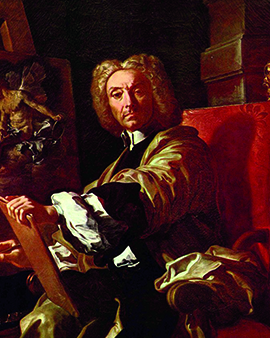In his 90 years of life, the Italian painter Francesco Solimena has achieved a lot. Artistically, he has gained a firm place in art history as the formative painter of the Neapolitan Baroque. Many experts even describe Francesco Solimena as one of the greatest European painters of his epoch. Solimena was also a master of self-expression. He sought contact with great names and patrons who recognized his talent and awarded him numerous commissions.
One of his clients was the French king Louis XIV, who was known as "Roi-Soleil", as the "Sun King", for his generosity. It was through him that Francesco Solimena's paintings found their way to the huge castle of Versailles. Eugen Franz, the famous Prince of Savoy-Carignan, who rose to become the most important general of the Habsburg monarchy, also ordered numerous pictures from Solimena. In the last years of his life, the already very old artist was often a guest of Charles III, who was King of Naples and Sicily at that time and later became King of Spain. All his clients loved Solimena's special painting style, which used the exuberance of the Neapolitan Baroque as a perfect means of expression. He mastered the art of creating in his paintings a special effect of light and shadow, which became typical for his entire work. Nearly all the paintings were created in his studio in the city of Naples, which he rarely left. His paintings, however, travelled throughout Europe. They hung not only in Versailles, but also in the Belvedere Palace in Vienna and decorated the walls of numerous noble palaces in the German principalities. As an artist, he was not only attracted by the canvas, he decorated countless church rooms with artistic frescos and also distinguished himself as an architect with the facade of the church San Nicola alla Carità in Naples.
His talent and hard work made Francesco Solimena a rich man who lived in Naples in a magnificent palazzo in Via San Potito. He designed and furnished the prestigious building himself. But Solimena did not only think of himself, but was strongly committed to the education of young painters. He himself had painted his first pictures in the studio of his father Angelo, where he enjoyed a privileged starting point for his career. The Academy he founded established itself as a centre of artistic life in Naples. The reputation of the institute reached far beyond Naples and many European art students found their way to the rich and fascinating city on the Mediterranean. Some of its students later became famous painters themselves. Sebastiano Conca and Francesco De Mura in particular reinterpreted the spirit of their great teacher and created magnificent paintings at the transition from Baroque to Classicism.
×





.jpg)
.jpg)
.jpg)
.jpg)
.jpg)
.jpg)
.jpg)
.jpg)
.jpg)
.jpg)
.jpg)
.jpg)
.jpg)
.jpg)
.jpg)
.jpg)
.jpg)
.jpg)
.jpg)
.jpg)
.jpg)
.jpg)
.jpg)
.jpg)
 - (MeisterDrucke-53004).jpg)
 - (MeisterDrucke-53004).jpg)
.jpg)
.jpg)
.jpg)
.jpg)
.jpg)
.jpg)
.jpg)
.jpg)
.jpg)
.jpg)
.jpg)
.jpg)
.jpg)
.jpg)
_-_(MeisterDrucke-1126996).jpg)
_-_(MeisterDrucke-1126996).jpg)
.jpg)
.jpg)
_oil_on_canvas_-_(MeisterDrucke-1091454).jpg)
_oil_on_canvas_-_(MeisterDrucke-1091454).jpg)
_-_(MeisterDrucke-1087753).jpg)
_-_(MeisterDrucke-1087753).jpg)
.jpg)
.jpg)
_Le_medaillon_au_centre_represente_le_-_(MeisterDrucke-1319399).jpg)
_Le_medaillon_au_centre_represente_le_-_(MeisterDrucke-1319399).jpg)
.jpg)
.jpg)
.jpg)
.jpg)
.jpg)
.jpg)
.jpg)
.jpg)
.jpg)
.jpg)
 - (MeisterDrucke-248951).jpg)
 - (MeisterDrucke-248951).jpg)
.jpg)
.jpg)
_oil_on_canvas_99x135_cm_-_(MeisterDrucke-1422407).jpg)
_oil_on_canvas_99x135_cm_-_(MeisterDrucke-1422407).jpg)
.jpg)
.jpg)
 - (MeisterDrucke-72550).jpg)
 - (MeisterDrucke-72550).jpg)
_-_(MeisterDrucke-902995).jpg)
_-_(MeisterDrucke-902995).jpg)
_from_Santa_Maria_Assunta_Cathedr_-_(MeisterDrucke-1094399).jpg)
_from_Santa_Maria_Assunta_Cathedr_-_(MeisterDrucke-1094399).jpg)
.jpg)
.jpg)
.jpg)
.jpg)
_(744-749)_at_the_Monastery_-_(MeisterDrucke-1029206).jpg)
_(744-749)_at_the_Monastery_-_(MeisterDrucke-1029206).jpg)
_-_(MeisterDrucke-1092809).jpg)
_-_(MeisterDrucke-1092809).jpg)
.jpg)
.jpg)
.jpg)
.jpg)
.jpg)
.jpg)
.jpg)
.jpg)
.jpg)
.jpg)
.jpg)
.jpg)
.jpg)
.jpg)
.jpg)
.jpg)
_in_America_Painting_-_(MeisterDrucke-983820).jpg)
_in_America_Painting_-_(MeisterDrucke-983820).jpg)
.jpg)
.jpg)
.jpg)
.jpg)
_-_(MeisterDrucke-1123006).jpg)
_-_(MeisterDrucke-1123006).jpg)
.jpg)
.jpg)
.jpg)
.jpg)
.jpg)
.jpg)
_-_(MeisterDrucke-1079569).jpg)
_-_(MeisterDrucke-1079569).jpg)
.jpg)
.jpg)
.jpg)
.jpg)
.jpg)
.jpg)
.jpg)
.jpg)
_Hunting_of_the_Temple_by_the_Angels_Painting_by_Francesco_-_(MeisterDrucke-1022548).jpg)
_Hunting_of_the_Temple_by_the_Angels_Painting_by_Francesco_-_(MeisterDrucke-1022548).jpg)
_-_(MeisterDrucke-1584381).jpg)
_-_(MeisterDrucke-1584381).jpg)
_-_(MeisterDrucke-902651).jpg)
_-_(MeisterDrucke-902651).jpg)
.jpg)
.jpg)
_-_(MeisterDrucke-1081111).jpg)
_-_(MeisterDrucke-1081111).jpg)
.jpg)
.jpg)
_oil_on_canvas_73x98_cm_-_(MeisterDrucke-1090511).jpg)
_oil_on_canvas_73x98_cm_-_(MeisterDrucke-1090511).jpg)
.jpg)
.jpg)
.jpg)
.jpg)
.jpg)
.jpg)
_-_(MeisterDrucke-1090582).jpg)
_-_(MeisterDrucke-1090582).jpg)
_-_(MeisterDrucke-901756).jpg)
_-_(MeisterDrucke-901756).jpg)
.jpg)
.jpg)
_oil_on_can_-_(MeisterDrucke-1089416).jpg)
_oil_on_can_-_(MeisterDrucke-1089416).jpg)
.jpg)
.jpg)
.jpg)
.jpg)
.jpg)
.jpg)
.jpg)
.jpg)
.jpg)
.jpg)
.jpg)
.jpg)
_-_(MeisterDrucke-1081368).jpg)
_-_(MeisterDrucke-1081368).jpg)
_-_(MeisterDrucke-1222635).jpg)
_-_(MeisterDrucke-1222635).jpg)
.jpg)
.jpg)
_-_(MeisterDrucke-899416).jpg)
_-_(MeisterDrucke-899416).jpg)
.jpg)
.jpg)
.jpg)
.jpg)
.jpg)
.jpg)
.jpg)
.jpg)
.jpg)
.jpg)
.jpg)
.jpg)
.jpg)
.jpg)
_(_-_(MeisterDrucke-1003160).jpg)
_(_-_(MeisterDrucke-1003160).jpg)
.jpg)
.jpg)
.jpg)
.jpg)
.jpg)
.jpg)
_-_(MeisterDrucke-1366164).jpg)
_-_(MeisterDrucke-1366164).jpg)
.jpg)
.jpg)
_-_(MeisterDrucke-1515986).jpg)
_-_(MeisterDrucke-1515986).jpg)






